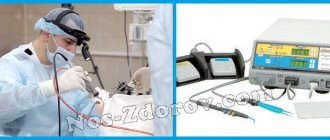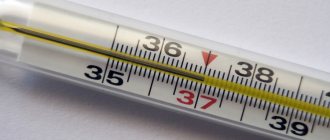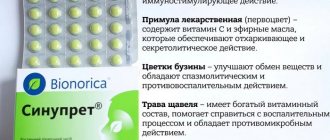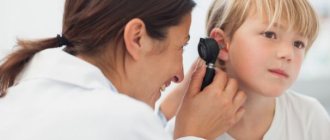Degrees of enlargement of adenoids
Current classification according to the degree of enlargement of the adenoids (and it determines the indications for drug or surgical treatment):
Classification of adenoids by degree of enlargement
| I degree | II degree | III degree | |
| Adenoid size | The adenoids cover the upper third of the vomer*. | The adenoids are medium in size, covering two-thirds of the vomer. | The adenoids are large, cover the entire or almost the entire vomer, and completely cover the lumen of the nasopharynx. |
| Difficulty breathing | In this case, breathing through the nose may be free or slightly difficult, more often during sleep. | Breathing through the nose is quite difficult. | Breathing through the nose is severely difficult, the child constantly breathes through his mouth, his lips are dry, covered with cracks and crusts. |
| Method of treatment | A course of conservative treatment is indicated. We talk about adenotomy if the child is often sick, complications occur, for example, recurring otitis media. | Both conservative and surgical treatment are possible. Indications for surgery are determined individually, the main criterion being complications and the incidence of illness in the child. If the child does not receive any treatment at all, the adenoid may enlarge. | The adenoid must be removed. If the child is not operated on in time, an abnormal bite and an elongated “adenoid face” will gradually form, which is subsequently difficult to correct. Even long-term treatment by an orthodontist does not always completely restore the correct facial skeleton. |
| *The vomer is a small plate made from bone and placed vertically. Together with the ethmoid bone, it forms the bony septum of the nose. | |||
Methods of conservative treatment of adenoids
The adenoid is an organ of the immune system. Its tissue contains cells that produce antibodies to pathogens. If conservative treatment is successful, this protective barrier is completely preserved. Antibacterial drugs are prescribed, since adenoiditis (inflammation of adenoid tissue) occurs primarily due to exposure to pathogenic microflora. To remove bacteria from the mucous membrane of the nose and nasopharynx, courses of nasal rinsing are carried out using a vacuum pump. Physiotherapy procedures, such as CUV tube, laser and magnetic devices, quickly relieve inflammation, improve blood circulation and local immunity. In the treatment of adenoids, not only an otolaryngologist, but also an allergist-immunologist is involved; he prescribes general tonic drugs that stimulate the body’s defenses in order to reduce the number of acute respiratory infections. But the effectiveness of conservative treatment methods is about 50% and there remains a risk of repeated exacerbations when faced with an infection, which means that symptoms may recur.
Indications for adenoid removal
An increase in adenoid vegetations forms a chronic focus of infection, reduces immunity, and disrupts the functioning of the auditory tubes. These changes in the body contribute to the indication for adenoid removal:
- ARVI and acute respiratory infections. An obstruction in the form of adenoids appears in the nasal cavity, which impedes the outflow of mucus. Mucus protects us from viruses, but when an obstacle arises, favorable conditions are created in the nasal cavity for the development of infections and inflammatory processes.
- Hearing impairment. The adenoid closes the opening of the eustachian tube, preventing the free passage of air into the middle ear. The eardrum loses its mobility, which is negatively reflected in the auditory sensation.
- Chronic inflammation of the nasopharyngeal tonsil (chronic adenoiditis). Inflamed adenoid vegetations are a good environment for infection to attack. Bacteria and viruses form in the nasopharyngeal tonsil, causing chronic adenoiditis, accompanied by a constant runny nose.
- Multiple otitis media. The growth of the nasopharyngeal tonsil disrupts the function of the middle ear, and favorable conditions are created for the spread and development of infections.
- Respiratory tract diseases - pharyngitis, laryngitis, tracheitis, bronchitis. With an increase in lymphoid tissue, chronic inflammation develops. Due to the growth, mucus and pus are constantly formed, flowing into the respiratory system. In case of contact with the mucous membrane, they cause inflammatory processes that lead to infectious diseases of the respiratory tract.
- Adenoid cough. This occurs due to the stimulation of nerve endings located in the nasopharynx and on the back wall of the pharynx. Most often, doctors associate a patient’s cough with colds and flu, but the patient does not have any bronchial dysfunction, in which case the cough may be a symptom of adenoids. When treating the adenoid, the cough goes away.
- Bronchitis, pneumonia
- Speech disorders
- Retarded physical development
- Neurological disorders – headaches, enuresis, convulsions
- Malocclusion with the formation of an “adenoid face”
- Ineffectiveness of conservative treatment
Removal of adenoids in children
Optimal age for adenoid removal in children
- 3-7 years. Postponing surgical intervention when there are indications for surgery can have negative consequences and cause diseases such as persistent hearing loss due to disruption of the auditory tube, the formation of viscous fluid in the tympanic cavity (exudative or adhesive otitis media), facial deformation, malocclusion, caries, tooth decay enamel, violation of teething. The presence of a chronic focus of infection in the body can cause diseases such as bronchial asthma, chronic glomerulonephritis (autoimmune inflammation of the kidneys) and weakens the immune system.
In the photo, the leading doctor of the clinic, Oganesyan Tigran Sergeevich, performs an operation to remove adenoids from a child under general anesthesia using a combined method.
Causes
Adenoiditis is often diagnosed in children over 2 years old; it is at this time that they begin to attend kindergartens and get sick regularly.
As the baby gets older, the risk of developing this pathology decreases. But it is important not to miss the first symptoms of the disease and start treatment, otherwise you can get serious complications. When adenoiditis occurs in a child, the process of teething is disrupted, the upper palate becomes pointed and the facial bones are slightly deformed. This condition is called “adenoid mask” and it is completely untreatable. Due to the fact that the enlarged adenoids block the airways, the baby develops oxygen starvation. Sick children may be developmentally delayed, restless and difficult to learn.
There are several reasons for the development of adenoiditis. These include poor heredity, viral diseases of the mother during pregnancy, some infectious pathologies and allergic reactions.
At the initial stage of the disease, adenoiditis can be cured using conservative methods. But at stages 3-4 of the disease, such treatment methods often have no effect, so doctors recommend laser removal of adenoids in children.
Frequent respiratory diseases, scarlet fever, diphtheria and whooping cough can lead to inflammation of the adenoids.
Adenoid removal in adults
There are cases when adenoids are diagnosed in adults. This is due to the widespread introduction of endoscopic methods for examining the nasal cavity into diagnostics. Manifestations may not be as pronounced as in childhood, so often complaints of nasal congestion, frequent runny nose, otitis, and mucus running down the back of the throat in adults can be regarded by doctors as symptoms of other diseases, which leads to ineffective treatment and aggravation of the situation.
Indications for adenoid removal in adults:
- snoring, breathing problems during sleep
- frequent colds
- chronic tonsillitis or pharyngitis
- difficulty breathing through the nose
- Postnasal drip syndrome (mucus running down the back of the throat)
- recurrent sinusitis or chronic sinusitis
- recurrent purulent or exudative otitis media, hearing loss
- bronchial asthma, chronic bronchitis
To remove adenoids or not?
Recent studies have shown that removing adenoids in children may increase the risk of developing other problems, such as allergies, asthma and chronic airway inflammation. This is the main reason why children are in no hurry to undergo adenotomy. In addition, any surgical intervention involves emotional stress and the possibility of complications. Therefore, surgery in childhood should only be considered if the adenoids are causing serious problems and there are no obvious alternatives to surgery.
In all situations where you can wait, you need to try conservative methods. Perhaps the cause of hypertrophy lies in inflammation, and it can be stopped with medication.
On the other hand, although tonsils are important for the developing immune system, they may do more harm than good. At some point, they will simply become a source of infection, which will undermine the immune system and negatively affect other ENT organs. And large adenoids even threaten the health and normal development of the patient. Therefore, if the previously listed indications are present, the operation should be performed even in very young children. Removing adenoids in children will help quickly eliminate the symptoms of the disease. The nose and ears also return to normal over time. And most importantly, the operation prevents complications.
When and at what age is it better to remove adenoids from a child? If the disease develops in a child at 2-3 years of age, and it causes serious inconvenience, then it is better to perform an adenotomy, although there is a possibility of re-formation of adenoids, because the lymphoid tissue will continue to grow. But parents of children 7-8 years old may already be thinking about waiting a couple of years until the adenoids involute on their own. But you can wait if the child still has nasal breathing and there are no complications.
Adults do not need hypertrophied tonsils at all, so removal of adenoids in adults can be carried out for any reason, because vegetation will not disappear on its own.
Methods for diagnosing adenoids
Classic methods for diagnosing hypertrophy of the nasopharyngeal tonsil are digital examination of the nasopharynx and examination of the posterior parts of the nasal cavity. But these procedures are difficult and provide little information, especially in the case of children. The most modern diagnostic method is endoscopic examination - a method of examining the mucous membrane of the upper respiratory tract with an endoscope. The advantage of endoscopy is that it is painless and safe; the doctor gets a complete picture of the size of the nasopharynx, the degree of enlargement of the adenoid tissue and the condition of the mouths of the auditory tubes. Together, these data make it possible to determine a treatment method and diagnose the disease at an early stage.
How to treat?
The fact is that medications chosen independently, like folk recipes, can remove the symptoms of the disease, but not its cause. The consequence of this can be serious illnesses, which will have to be treated in the hospital.
The future is near
One of the most gentle and fastest, and therefore popular, ways to get rid of chronic diseases and swollen tonsils is laser. Laser treatment of adenoids in children is especially popular because it is easy and painless.
The laser method has its positive and negative sides, as well as caveats that are worth taking a closer look at.
Adenoid removal methods
Instrumental method of adenoid removal
To remove adenoids
you need a special scalpel - Beckmann's adenotome. The adenotome is inserted into the nasopharynx and positioned in such a way that all the tissue to be removed fits into the adenotome ring. And the adenoid is cut off. The bleeding stops on its own within a few minutes. The advantage of the operation is that it is performed under local anesthesia and on an outpatient basis. The downside is that the removal is carried out “blindly”, that is, by cutting off the tissue, the doctor is not able to see the nasopharynx cavity, and therefore check whether there are particles of adenoid tissue remaining, which can lead to regrowth (relapse).
Radio wave method for removing adenoids
The operation is performed using the Surgitron device with an attachment for removing the adenoid - a radio wave adenoid. The radio wave adenoid cuts off the adenoid in one block, as in a classic operation, but at the same time the radio wave coagulates (cauterizes) the vessels, so bleeding during such an operation is minimized. The advantage of the technique is the reduction of blood loss during surgery and the risk of bleeding in the postoperative period.
Laser removal of adenoids
One of the modern achievements in the field of surgery is the use of laser. Under the influence of laser radiation, the temperature of the tissue increases and liquid evaporates from it. This method is bloodless. However, it has disadvantages - the operation time increases significantly, and heating of healthy tissue in the area of laser exposure can occur.
Removal of adenoids with a shaver (microdebrider)
A microdebrider is a tool with a rotating head and a blade at the end. With its help, the adenoid is crushed, and then aspirated into a suction reservoir, which also allows you to quickly and completely remove adenoid vegetations, without damaging the healthy mucous membrane of the nasopharynx, this is important, since otherwise bleeding occurs, and subsequently scars form. The operation using a microdebrider is performed under anesthesia with endoscopic control. This is the most progressive method of adenotomy, in which the risk of relapse is minimal.
In the photo, the leading doctor of the clinic, Oganesyan Tigran Sergeevich, using a shaver, performs manipulation as part of an operation to remove adenoids from a child under general anesthesia using a combined method.
Our clinic uses a combined removal method. We use the advantages of each of the above methods, this gives greater efficiency, the operation is much faster, the risk of complications is reduced, and the postoperative period for the child is much easier.
Comparative characteristics of adenoid removal methods
| Instrumental method | Radio wave method | Laser method | Shaver removal | |
| What is used | Scalpel - Beckmann's adenotom |
|
|
|
| Anesthesia |
|
|
|
|
| pros |
|
|
|
|
| Minuses |
|
|
|
|
Stages of implementation
The laser adenoid removal procedure includes the following steps:
- Preparatory stage. During this period, the person undergoes an examination, including a clinical blood and urine test, x-ray or computed tomography of the nasopharynx, as well as consultation with specialists (neurologist, surgeon, allergist).
- The stage of direct removal of hypertrophied areas of the tonsils.
- Rehabilitation stage.
Laser treatment of adenoids in children is carried out on an empty stomach. A person is given a restriction or a complete ban on drinking liquids. Before starting the procedure, the doctor performs an antiseptic treatment of the patient’s oral and nasal cavities. The next step is the administration of an anesthetic drug, which was previously selected by a medical specialist.
Laser treatment of adenoids is carried out using the following methods::
- Coagulation technique. It is characterized by the removal of hypertrophied tonsil tissue using focused laser radiation. This technique is carried out to remove large growths of tonsil tissue.
- Resection with carbon dioxide laser. Applicable for eliminating adenoids in the initial stages of the disease.
- Combined technique. This method uses a regular scalpel to remove hypertrophied areas, followed by the use of a laser.
Laser therapy for adenoids lasts 15-30 minutes. An improvement in a person’s condition is observed 2-3 days after the procedure.
Preparing for surgery to remove adenoids
Preliminary preparation consists of undergoing a complete examination of the patient. The examination includes:
- General and biochemical blood test
- Analysis of urine
- coagulogram
- blood test for infections (hepatitis B and C, syphilis, HIV)
- ECG
- pediatrician examination
On the eve of removal, after 6 pm you should refrain from eating, it is recommended to have a light dinner, and you should not even drink water in the morning.
Absolute contraindications for adenoid removal:
- pronounced disorders in the blood coagulation system
- oncological diseases
- pharyngeal vascular abnormalities
Adenotomy is not performed during acute infectious diseases and within 1 month after vaccinations. In teenage girls, surgery is planned for the period before or after menstruation.
How to prepare for surgery
On the day of the procedure, the child must be healthy: a slight runny nose or cough will have a detrimental effect on the body after removal. In case of illness, the little patient is operated on another day.
The medical history includes information about vaccinations or medical exemption from vaccination.
Preparation for the procedure includes 5 tests:
- general blood test (ESR, leukogram, platelets);
- blood test for coagulation (CBC or coagulogram);
- general urine analysis;
- X-ray or computed tomography of the sinuses;
- biochemical blood test (protein, creatinine, urea, electrolytes, AST and ALT).
If the adenoids are excised under general anesthesia, then an additional test for blood type and Rh factor is prescribed. All tests are collected within 2 days before surgery.
Before anesthesia, you need to check your blood type and Rh factor
For children, it is preferable to perform the operation under general anesthesia to minimize fear and stress in the child. If local anesthesia is to be administered, then a conversation is held with the patient and he is prepared psychologically as much as possible.
12 hours before the procedure you should not eat anything; on the morning of the day of surgery you are allowed to drink some liquid to eliminate the risk of vomiting, which may be caused by anesthesia.
Anesthesia for adenoid removal
Local anesthesia
In children over 7 years of age, adenotomy under local anesthesia is possible. Before the operation, a sedative is administered intramuscularly to the child, an anesthetic solution (10% lidocaine solution) is sprayed into the nasopharynx, and then a less concentrated anesthetic solution (2% lidocaine or ultracaine) is injected into the adenoid tissue to enhance the anesthesia effect. During the operation, the child is conscious and perceives everything that is happening around.
General anesthesia (anesthesia)
In children under 7 years of age, adenotomy is performed under general anesthesia (anesthesia), so the intervention takes place without pain and, which is especially important for the child, without psychological stress. The clinic uses drugs that belong to a high safety class, they are non-toxic, do not cause such complications, so anesthesia is easily tolerated even in childhood and feels similar to normal sleep.
In the photo, an anesthesia device from the German company Drager is used in the clinic.
Doctors anesthesiologists
The clinic employs highly qualified anesthesiologists, including specialists from the Children's Clinical Hospital named after. N.F. Filatov, who have academic degrees of candidates and doctors of medical sciences, many years of unique work experience. Our specialists use an anesthetic apparatus from the German company Drager and the latest generation of medicines. All this allows removal under general anesthesia (anesthesia) that is safe for the patient’s health, with rapid recovery in the postoperative period.
Anesthetics used
In their work, anesthesiologists use the drugs Sevoran, Diprivan, Esmeron, Enfluron, Isoflurane, Dormicum and others. The choice of a specific drug is at the discretion of the anesthesiologist and depends on each specific case, test results and other factors.
How is adenoid removal performed?
Endoscopic equipment provides good visual control, and the doctor can very accurately remove hypertrophied lymphoid tissue - this can significantly improve the quality of the operation and reduce the possibility of relapses.
Our clinic uses a combined method of removal using a shaver and a radio wave adenotom - this is a modern high-tech method. The use of a shaver and radio wave adenotom significantly reduces the recovery time after surgery.
The postoperative period is easy in most cases. In the evening after adenoid removal or the next morning, the patient may have a fever.
Immediately after the operation, there is a noticeable improvement in nasal breathing, but in subsequent days the child may develop nasal sounds, nasal congestion, and “sniffling in the nose.” This is due to the presence of postoperative swelling, which subsides by 7-10 days.
Adenotomy in adults is performed mainly under local anesthesia (the removal technique is similar to surgery in children). If another intervention is performed at the same time, for example, septoplasty and adenotomy, then the operation is performed under general anesthesia. If the adenoid is small, it can be removed using the radio wave method. The rehabilitation period is easy, but in the case of chronic diseases, tissue healing may occur more slowly than in children.
Contraindications to laser
It is prohibited to carry out laser treatment of enlarged tonsils if:
- blood clotting disorders;
- acute inflammation in the nasopharynx;
- systemic infectious disease in the acute stage.
When carried out correctly, the laser technique has the maximum effect and helps to completely restore nasal breathing in children, as well as avoid possible relapses.
We advise you to read: removal of appendicitis using the laparoscopic method
Staying in hospital
After removal of adenoid vegetations, doctors recommend staying in a hospital under the supervision of an on-duty specialist. Usually this takes no more than a day. The advantages of being in a hospital are that the risk of complications is reduced and the best post-operative recovery is guaranteed.
In the photo, a ward in the hospital of the Ear, Nose and Throat Clinic.
After surgery, physical activity should be avoided for one month. The child should not be bathed in hot water for three days. It is important to maintain proper nutrition. It is better to avoid exposure to open sun and stuffy rooms.
Postoperative period
In the first few hours, the child's temperature rises. This is normal, it is not recommended to knock it down while the thermometer shows less than 38 degrees. If the fever gets worse, you can use Paracetamol or Ibuprofen.
Recovery of the body after removal of the adenoids takes up to a month, during which the following activities are recommended:
- Limiting physical activity: do not leave the house for the first week.
- Following a diet, eating only soft foods: porridge, mashed potatoes, grated vegetables. It is important that the food is not hot, cold or spicy and does not contain large hard pieces.
- Refusal of hot baths and visits to baths or saunas. In the case of infants, do not bathe the child in hot water for 3 days. Heat increases local blood circulation, and there is a risk of bleeding.
- It is advisable not to visit places with large crowds of people for the first 2 weeks in order to protect the child from potential carriers of respiratory diseases. School and kindergarten included.
- On the recommendation of a doctor, use vasoconstrictor nasal drops for healing (Protargol or Xylin).
- Switch to active breathing through the nose using breathing exercises 10-12 days after surgery. During the first week, out of habit, the child will continue to breathe through his mouth; gymnastics will restore the respiratory reflex.
- Maintaining a sleep schedule. At least 8 hours a day. Especially important after laser removal.
After surgery you need to switch to nasal breathing
During the first few days of rehabilitation (usually from 3 to 7), the child may complain of a sore throat while eating. If the pain is tolerable, then there is no need to sound the alarm; the wound is healing.
Important!
If treatment goes smoothly, a white fibrin coating will appear on the tonsils within a few days to protect the mucous membrane during recovery. Over time, the plaque comes off without the child noticing.
Recommendations for maintaining health after adenoid removal
After surgery, restorative and restorative therapy is necessary to prevent relapse. General hardening of the body, breathing exercises, as well as treatment and observation by an allergist-immunologist, especially when it comes to children with concomitant diseases such as atopic dermatitis, bronchial asthma, allergic rhinitis. Normalizing the functioning of the immune system is very important - by increasing resistance to infections and colds, the likelihood of lymphoid tissue proliferation decreases.











